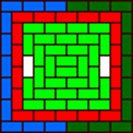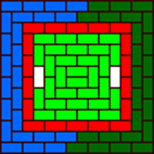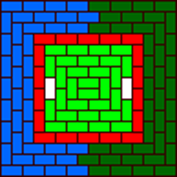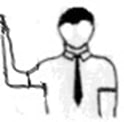International rules of organization and holding of Kurash competitions
Adopted by the First Foundational Congress of the IKA on September, 6, 1998 in Tashkent, Uzbekistan
The regulations for competitions are drawn up and approved by the
organization which arranges these competitions. The regulations shall include the
following:
• Type of competition;
• Purpose of competition;
• Sport features, age, sex, name of teams and organizations;
• Place and date of conducting a competition;
• Order of conducting a competition;
• Conditions of participation in competition;
• Responsible organization for conducting a competition;
• Board of referees;
• Fight duration;
• Deadline for submitting applications for participation in the competition;
• Medical control procedure and maintenance of order;
• Documents to be submitted to the credentials committee;
• Claims submission procedure and their consideration;
• Date and time of conducting a competition in each weight category;
• Procedure of awarding ceremony.
• Individual championship.
• Team championship.
• Individual and team championships.
• Open gilam (tatami) championship.
• Absolute championship.
1) An individual championship is held to determine the strongest Kurash athletes of the
competition.
2) In team championship the place of every team is determined.
3) In individual and team championships, the place of every participant is determined,
and according to that, the place of every team is determined.
4) In open gilam (tatami) championship every Kurash athlete fights to increase their sport
qualification, title and experience.
5) In the absolute championship, the strongest k Kurash athletes are determined regardless
of weight category.
1) Prior to conducting every competition, the federation conducting this competition on its territory submits a list of referees approved by this federation. Every competition
from the calendar of international tournaments, continental championships, World Championship and Olympic Games, may be attended only by referees, authorised by
the International Kurash Association.
2) Structure of the Board of referees:
a. Chief Referee; (Technical Director)
b. Сhief Referee deputy, their number shall be more according to the number of
gilams (tatamis), on which the competition is held;
c. Chief Secretary and secretaries of gilam (tatami);
d. Arbitrator and side referees;
e. Stop-watch referee;
f. Scoreboard referee;
g. Informing referee;
h. Warden of competition;
i. Medical staff (doctor of competition).
3) Referees, entering gilam (tatami), put their right hand on left part of breast and
simultaneously bow to spectators and Chief Referee.
4) Chief Referee and Board of referees control referees’ actions. If referees admit actions
contradicting competition rules, they are discharged from the competition and deprived
of their referee’s license.
1) The Chief Referee (Technical Director) is the head of the competition and is responsible for conducting it according to the rules. Participants, team representatives,
the board of referees, and attendants should implicitly execute the instructions of the Chief Referee.
2) Chief Referee’s (Technical Director) Responsibilities:
a. To control the layout of a sport building (gymnasium or stadium), equipment and
gilam (tatami) with competition requirements list;
b. During the draw to divide the strong Kurash athletes in two subgroups (seedings);
c. to distribute referees on gilams (tatamis);
d. to make the schedule of the competition;
e. to nominate referees for Kurash athletes;
f. to nominate referees to each fight and to supervise their actions;
g. prior to the beginning of competition, to hold a meeting of Board of referees;
h. every day after the end of competition, to gather Board of referees and ITOS, to
summarize competition’s results, eliminate complains, received during
competition (If any officially written).
i. if necessary, to hold an assembly of Board of referees;
j. to evaluate readiness of referees for competition and the course of competitions;
k. to fill in and check and approve the results of competition and to hand to
appropriate bodies.
3) Rights of Chief Referee (Technical Director):
a. to suspend and to forbid conducting the competition if the place of conduction,
equipment and gilam (tatami) are not prepared and do not meet rules or
requirements;
b. to temporarily suspend competition, if there is something that may negatively affect
conducting the competition on the high level;
c. to make changes in the procedure of conducting the competition or the schedule of
competition;
d. to discharge referees for violation of rules and give information about it to the
Board of referees;
e. to discharge the Kurash athletes who violated rules or does not have permission
for participation in competition;
f. to caution or to discharge a coach of any team for violation of Kurash rules or for
inappropriate behavior during competition.
Note: Chief Referee (Technical Director) has no right to cancel or change Kurash rules. Any changes
or suggestions to the regulations/rules must be put forward to the IKA Directing Committee and
approved by the IKA Congress.
1) During the temporary absence of the Chief Referee at the competition, fulfills their
responsibilities;
2) Arranges and announces results of fight and names of Kurash athletes fighting next;
3) Arrange the referees for the next fights.
1) The Chief Secretary examines the documents of Kurash athletes while they pass the
credentials committee.
2) The Chief Secretary keeps the minutes of assembly of Board of referees, of fights and
other documents.
3) Secretaries keep the record of gilams (tatamis).
4) Secretaries write down results and remarks on fights in the minutes (Fight order sheet).
5) The Chief Secretary and Sports Director together with Chief Referee (Technical
Director) is obliged to fill in and to sign the minutes-report of competition.
Before the beginning of a fight, the arbitrator examines the condition of the Kurash athletes, their Yakhtak according to Kurash rules, if there is a disparity, he shall
demand to change the Yakhtak (in prescribed time).
2) If a player appears on the Gilam wearing a non-standard Yakhtak, the referees have the right to disqualify the player (Girrom). Wearing a standard Yakhtak is the sole duty of
the player and not the organisers.
3) The arbitrator controls the course of the fight and observance of Kurash rules.
4) Takes into account appraisals of side referees.
5) After every appraisal of the implemented methods, the arbitrator shall stop the fight (with a command TOKHTA!), give appraisal during 2-3 seconds and begin Kurash
with the command KURASH!
6) While announcing penalty for violation of rules the Arbitrator shall stop (with the command «TOKHTA») the fight and in 15-20 seconds shall announce penalty (in this
period of time Kurash athletes shall remain on their places and put in order their Yakhtak) and begin it with command «KURASH».
7) Once the stop-watch referee signals the end of fight time (on the score board or a horn/bell), the arbitrator shall stop the fight with the command VAKT! and an
appropriate gesture.
1) Side referees shall help the arbitrator to evaluate all actions of Kurash athletes.
2) Three referees on majority basis evaluate all actions of Kurash athletes on gilam (tatami). If opinions of three referees do not coincide, they must discuss it to get final
opinion.
3) Side referees sit on the opposite parts of gilam (tatami), (not blocking the score board).
4) If a participant needs to leave gilam (tatami) for a short time, he shall be accompanied by one of the side referees (of the same gender as the athlete).
1. The stop-watch referee watches the duration of the fight and the time when the wrestlers come on gilam (tatami).
2. The stop-watch referee calculates and controls every minute of fight time. If the wrestler uses medical help during the fight or wrestling is stopped because of any other reason, the stop-watch referee counts the duration of stop and informs immediately Chief Referee.
The scoreboard referee shows on the score-board all appraisals and penalties announced by the arbitrator.
2) If the scoreboard referee does not have enough time to see or hear the arbitrator’s result announced, he/she asks the secretary of glam (tatami) about it.
3) The final score shall remain on the scoreboard until the winner is announced.
1) The informing referee announces the schedule of the day, weight categories, names of the next pair of Kurash athletes to fight. Gives the information on each Kurash athletes
entering gilam (tatami). Also gives the information to spectators about the referees on gilam (tatami).
2) All information on competition is given only after approval by the Chief Referee or
their deputy.
1) The warden (Sports Director) of the competition is responsible for readiness of the gymnasium, stadium or field where the competition will take place, gilam (tatami) on
which the fight will be held, referees’ table and chairs and other accessories;
2) The warden (Sports Director) of the competition is responsible for the order during the competition.
3) The warden of the competition conducts their activity per orders of the Chief Referee (Technical Director).
1) Before the beginning of the competitions the doctor of the competition examines medical reference (if needed) of the Kurash athlete, signature and seal, if there are
defects, does not allow the Kurash athlete to fight.
2) The doctor of the competition treats the Kurash athletes’ injuries during competition
(Only when called by the center referee).
1. Situations not stipulated by Kurash rules are solved by the Board of referees.
1. The referee uniform includes a black suit and trousers, black socks, white shirt and black tie.
1) The participants of the competition shall wear a dark blue or green yakhtak, white trousers, a red belt. And, the participant called first comes in a dark blue dressing gown,
and the second one — in a green dressing gown. Types of colors used: blue — 5-zm; green — 4-kx.
2) The Yakhtak shall be made from cotton, be in good condition, the material shall not be very rigid or dense.
3) The following marking is allowed:
a) State Emblem (on the left part of breast, maximum size: 10х10 cm);
b) trade mark of manufacturer (3х3 cm in front below the jacket);
c) shoulder marking (not more then 25 cm, width up to 5 cm);
d) tabs (25х25 cm, allowed on back, may include Kurash athletes’ surname).
4) The yakhtak shall be 15-20 cm above knees. The yakhtak sleeves shall not cover wrists. 8 cm shall be between a hand and a sleeve. The trousers shall be up to feet. 15-
20 cm shall be between a trouser-leg and a leg. A belt shall be 4-5 cm in width. It shall be such in length that after two turns round the waist and tying up, the ends still have
not less than 20 cm in length.
5) Women-participants shall wear a durable white sports shirt or tricot with short sleeves
under their yakhtak, tucked into trousers.
6) The Kurash athletes of both sexes Kurash on bare feet.
Clothes of participants (yakhtak and trousers) shall be clean, dry, without a bad smell. Nails on hands and feet shall be shortly cut. Long hair shall be assembled, in order not
to cause inconveniences to the other Kurash athletes. Any participant violating rules of hygiene, loses their right to participate in competition.
1) Kurash gilam shall have minimum size 10х10 m. The maximum size is 16х16 m, it shall be covered with a fabric, colored usually green, white, red, light-green, dark blue.
(IKA Recommended Blue and Green and Obligatory color at all GAMES)
2) Gilam of competitions is divided into two zones. The line dividing these zones, is called
«the dangerous line».
3) The fight area inside the line, including the dangerous line itself, is called «the safe zone», with minimum size 8х8 m, and maximum size 14х14 m.
4) The zone beyond the red line is called “safety Area”, 3 m in width.
5) The white lines 1 m in width and 2 m in length on two sides, designate the place of beginning and end of fights. These lines are drawn in the safe zone no more than in 6
m from each other (optional).
6) The gilam shall be on an elastic floor or a special platform. There shall be a free zone not less than 1 m in width surrounding the Kurash. Kurash gilam is made in following
sizes:
200 х 100 х 4 cm or 5 cm
100 х 100 х 4 cm or 5 cm
100 х 100 х 4 cm or 5 cm
| 12 х 12 m | 14 х 14 m | 16 х 16 m |
 |
 |
 |
| Red 18 pcsLight green 30 pcsWhite 2 pcsBlue 11 pscGreen 11 pcs | Red 18 pcsLight green 30 pcsWhite 2 pcsBlue 24 pcsGreen 24 pcs | Red 18 pcsLight green 30 pcsWhite 2 pcsBlue 39 pcsGreen 39 pcs |
1) At each gilam (tatami) there shall be:
a) a table and three chairs
b) two light chairs
c) a stop watch
d) a microphone
e) a score-board (showing the pure time of a fight) with a sound signal of the end of fight.
2) Two light chairs shall be located in the safe zone in the opposite corners, not closing the score-board.
3) The scoreboard should be located outside the working zone so that referees, members of the Board of Referees, and spectators can easily see it/them (a mechanical
scoreboard must always be reserved for control). The scoreboard should meet the requirements of the International Kurash Association.
4) In case of use of electron clock, mechanical clock is used for control.
5) Gong or a sound device shall be used to signal the arbitrator about the end of the fight (if there are more than two sets of Gilams different sounded Gongs must be used).
6) Spectators (press, TV, etc.) shall not be closer than 3 m from the gilam (tatami) of competition.
7) Manual stop watches (chess clock) and scoreboard shall be used simultaneously with
electronic equipment in case of failure of electronics.
1) Before the beginning of every fight three referees (arbitrator, two referees) come together on the edge of the gilam (tatami) and, putting right hand to the left part of
breast, bow and then take their places. Getting off the gilam (tatami) the referees come together on the edge and bow again with their right hands on left breast.
2) The participants with their right hand on the left breast, shall bow before coming in the safe zone. After bowing before the safe zone, the participants shall move forward up
together to the specially marked place, then, with right hand on left breast, they must bow to each other.
3) After the arbitrator announces the result of the fight, the participants with right hand on left breast, shall bow to each other (must exit at the same time).
4) Arbitrator and side referees shall take their places before the fight prior to participants’ coming on gilam (tatami).
5) All bows are executed by bending in waist forward. If participants do not bow, the arbitrator shall require their bowing.
6) Examining the fight square before the fight, referees shall check if the gilam (tatami) surface is plane, clean, without slots between mats, the chairs of referees are on their
places, the participants meet the requirements of the rules. The arbitrator shall be in the center of the gilam (tatami) initially facing the time-registration table.
7) The arbitrator when giving the command TOKHTA! shall see the participants.
1) Only the team representative has the right to directly address to the Chief Referee and their deputies.
2) Team chief is responsible for Kurash athletes’ Yakhtak, their well-timed coming on gilam (tatami) and for general order.
3) Team chief also ensures that two people will participate at the draw.
4) During the fight team chief shall be seated at special allocated zone for them.
5) Team chiefs / Coach having infringed the above-stated rules, are dismissed from their post and the appropriate organizations shall be informed about it.
6) Team coach cannot come nearer to the Kurash athletes in case of Kurash athlete’s
injury when the Kurash athlete is receiving medical aid from the doctor.
1) Participants of one weight category are weighted on the same day, on the same scales, two hours before the competition.
2) The weight-in shall proceed no more than one hour.
3) At weight-in Kurash athletes shall have their identification cards.
4) Without being weighted a Kurash athlete is not admitted to competitions.
5) During weight-in Kurash athletes shall wear only shorts or swimming trunks.
6) At weight-in of Kurash athletes, there shall be a commission composed of the Chief Referee, the Chief Referee deputy, secretary, medical staff member, 2 or 3 referees.
After weight-in, surnames of Kurash athletes are written in the minutes of scaling..
Age and weight categories for male players (for 2025):
• Children (4-7 years, born in 2021-2018 years) – 8, 9, 10, 11, 12, 13, 15, 17, 19, +19 kg
• Children (8-11 years, born in 2017-2014 years) – 20, 21, 23, 25, 27, 30, 33, +33 kg
• Children (12-13 years, born in 2013-2012 years) – 33, 36, 40, 44, 48, 52, 56, 60, 65, 70, +70 kg
• Cadets (14-15 years, born in 2011-2010 years) – 38, 42, 46, 50, 55, 60, 65, 71, 77, 83, +83 kg
• Juniors (16-17 years, born in 2009-2008 years) – 42, 46, 50, 55, 60, 65, 71, 77, 83, 90, +90 kg
• Seniors (17-35 years, born in 2008-1990 years) – 60, 66, 73, 81, 90, 100, -120, +120 kg
• Veterans (age groups: 36-45, 46-55, 56-60, 61-65 years and above, born in 1989-1980, 1979-1970, 1969-1965, 1964-1960 years and above) – 60, 65, 70, 75, 80, 85, 90, 95, +95kg
2) Age and weight categories for female players (for 2025):
• Children (4-7 years, born in 2021-2018 years) – 8, 9, 10, 11, 12, 13, 15, 17, +17 kg
• Children (8-11 years, born in 2017-2014 years) – 18, 19, 20, 22, 24, 27, +27 kg
• Children (12-13 years, born in 2013-2012 years) – 30, 33, 36, 40, 44, 48, 52, 57, +57 kg
• Cadets (14-15 years, born in 2011-2010 years) – 33, 36, 40, 44, 48, 52, 57, 63, +63 kg
• Juniors (16-17 years, born in 2009-2008 years) – 36, 40, 44, 48, 52, 57, 63, 70, +70 kg
• Seniors (above 17 years, born in 2008 and above) – 48, 52, 57, 63, 70, 78, 87, +87 kg
3) Irrespective of the weight category, youths and adults can (with the sanction of the
Chief Referee) participate in competitions in absolute weight category.
1) Males:
from 4 to 11 years — 2 minutes of pure time
from 11 to 16 years — 3 minutes
from 16 to 35 years — 4 minutes
from 35 to 56 years — 3 minutes
from 56 years and above — 2 minutes
2) Females:
from 4 to 16 years — 2 minutes
from 16 to 35 years — 3 minutes
from 35 years and above — 2 minutes
1) The participants of competition are required to have the following:
a. identification card, above mentioned uniform (Standard Yakhtak), document
verifying Kurash athlete’s class;
b. Check the Nationality
2) With the sanction of the Chief Referee, youths (16-17 years) may also participate in
adults’ competitions.
3) Kurash athletes competing in one weight category are not permitted to participate in
another weight category, but they may fight in absolute weight category with the
sanction of the Chief Referee.
The participants of competition shall observe the following rules:
• greet one another by a bow (TAZIM) before the beginning and after the end of
the fight.
• observe all Kurash rules and rules of competition.
• obey the referee’s instructions.
• behave correctly during competition.
• if referee calls a Kurash athlete, they shall immediately go to the designated
place.
1) Kurash athletes fight according to the adopted rules. Techniques and penalties are evaluated by referees.
2) If Kurash athletes have equal appraisals Score, victory is given according to the last appraisal Score.
3) If a participant has an appraisal – Score and a caution – Penalty, the appraisal has advantage.
4) If Kurash athletes got equal number of cautions, victory goes to Kurash athlete who got caution first – Penalty.
5) Competitions are conducted according to the knock-out system without repechage fights.
6) In Kurash the method, begun inside the gilam (tatami) and finished outside the gilam (tatami) line is evaluated as inside executed Technique.
7) The IKA shall follow the regulations and requirements set by the WADA (World Anti-Doping Agency) in terms of fight against doping. The use of any substances designed
to artificially increase the performance of an athlete and those in the list of prohibited substances set by the WADA shall be strictly forbidden by the IKA.
8) Participants of the IKA’s official events shall not oppose Doping control testing.
9) The decisions concerning penalties for doping abuse shall be based on the international anti-doping regulations and shall be made by the IKA’s Doping By-Laws.
| 1. TAZIM to spread hands on the level of shoulders with palms turned upward, then, bending hands in elbows to join the fingers before oneself with palms turned downward «TAZIM» is the command for a bow of the Kurash athletes one to another, with right hand on the left breast. |
 |
| 2. KURASH to hold out a straight hand before oneself, the palm shall be opened and thumb shall be directed upwards «KURASH» is the command for beginning the fight. |
 |
| 3. TOKHTA to raise a hand forward parallel to gilam on altitude of shoulder, with a palm turned forward, the palm shall be directed to the stop-watch referee «TOKHTA» is used to stop a fight. |
 |
| 4. KHALOL (pure victory) raise a hand high above head, with palm directed forward. • for two throws evaluated by YONBOSH scores; • if after the grid the opponent falls on their back (on both shoulder-blades); • after announcement of «GIRROM» punishment; • for the throw evaluated by YONBOSH, and the opponent has penalty of DAKKI; • for not coming to gilam (tatami) in 3 minutes; • when a player is injured and cannot carry on due to his own fault Khalol will be given to his opponent. |
 |
| 5. YONBOSH to raise a hand on the level of shoulder from the side, with palm turned downwards This score is given: • when Kurash athlete made a throw by a strong, sharp, beautiful motion and opponent falls on their side; • after the announcement of DAKKI Penalty to the opponent. • or a technique that misses one element from becoming Khalal. |
 |
| 6. CHALA to raise a hand, bent in elbow at 90 degrees, so that the thumb is on the level of the shoulder, the palm is open and is directed forward, the elbow is taken aside This score is given: • if a Kurash athlete throws the opponent on buttocks or belly, but with serious technical errors, slowly and inaccurately; • if TANBEKH penalty is announced; • CHALA scores, irrespective of their quantity, could not be transformed into a higher score. • if both Kurash athletes have several marks of CHALA the victory is given to one who has more marks of CHALA. |
 |
| 7. TANBEKH to point at the participant with a forefinger (showing the reason for the penalty). TANBEKH is announced to the participant, who made first minor violations. |
 |
| 8. DAKKI to raise a hand, bent in elbow at 90 degrees, clenched in fist, with fingers turned forward, and the elbow thus is taken aside. |
 |
| 9.GIRROM to hold a hand, bent in elbow at 90 degrees, being before oneself with a palm, directed towards one’s body, then by a sharp motion to straighten the hand towards the punished participant. |
 |
| 10.BEKOR BEKOR is given: • when there is no valid score or penalty; or • to change the previous given penalty or score. The referee waves their straight arm in front of the athlete facing their palm down from left to right 3-4 times to change a score or penalty. First, the referee shows the score or penalty they need to change and at the same time they show BEKOR command with other hand, the both hands come down and they show the correct score or penalty. |
 |
| 11) JAZO In case if by half time of the bout none of players have any score or penalty, the center referee shall stop the bout and announce the “Jazo”. When the “Jazo” is announced, the center referee shall rise his right arm up with fingers fisted-in and say loudly “Jazo”. 1) “Jazo” shall be announced only once at a bout. If during “Jazo” players perform a technique and both fall on the Gilam similarly at the same time, “Jazo” shall be carried out again. 2) When “Jazo” is announced the corner referees shall check the yakhtaks of the closest players respectively (if needed). The center referee shall call the players to the center of the Gilam. The players shall grip on the belt of the opponent (right hand under the left hand of opponent, left hand over the right hand of opponent) and once the center referee announces “Kurash”, they shall start action. The distance between two arms gripping the belt shall be 20 centimeters. Head of players shall be parallel to each other. The players must be upright. Chests of the players must be in touch. Any bending and avoiding gripping is strictly prohibited and shall be penalized by the referees immediately. 3) The players shall perform a technique. The player eluding from fighting or purposely falling on knees shall be given “Tanbekh”. If any of the players purposely releases the belt grip trying to avoid being thrown the referees shall give “Tanbekh”. 4) If during the “Jazo” a player gets “Khalol”, the bout is finished. If any player gets “Yonbosh” or “Chala” ot any penalty, the bout shall be continued in normal Kurash without belt gripping with remaining time of the bout. 5) The clock stops during “Jazo” and restarts after the score or penalty. |
 |
| 12. VAKT cross both hands above the head with palms directed downwards, the “VAKT” command is used to show the end of the fight. |
 |
Notes: Gestures are shown with right and left hands according to color of yakhtak of Kurash athletes standing on two sides of Referee. When showing the gestures Referee stands still in the center of Gilam and shall announce the corresponding commands with a loud voice.
1) TANBEKH
This score is awarded:
• Block without attacking (more than 10-15 Sec)
• Twist the collar to prevent grip or attack
• Go outside the competition area without technique or to push the opponent out without any technique.
• Tear the grip with knee
• Bend back the fingers (interlock, grab and break the fingers)
• Keep your collar from being grabbed
• False attack
• Technique after referees’ announcement of Tokhta (Stop) or Vaqat
• Purposely kick with the leg or hit with the arms
• Grab the pants
• Roll up the sleeves of the arms
• Strangle
• Arm locks
• Refusing to do the correct tazim
• Time delay on appearance
• Speak to the opponent or Referee
• Take off or undo, disorder the Yakhtak without the referee’s permission.
• Misbehavior
2) DAKKI
DAKKI is announced to the participant, who made a medium violation, or has already received a TANBEKH Penalty.
3) GIRROM
GIRROM is announced to the participant, who has already received a DAKKI Penalty:
• Misbehavior towards, referee, opponent, public, commissions etc…
• if a Kurash athlete is injured by fault of the opponent, they receive a KHALOL score and the opponent receives a GIRROM Penalty.
• If on the gilam and the Yakhtak not being standard with rules and regulations of IKA the referee will call Girom (Please note that it’s the athlete’s responsibility to wear standard Yakhtak)
• Head Dive
• Drinking liquid during the fight
• Wearing any hard objects covered or not.
PLEASE NOTE ALL GIRROM CASES MUST HAVE THE DECISION OF MAJORITY OF 3 REFEREES
At every gilam there must be a separate scoreboard. The received appraisals must be shown on a two-color scoreboard:

1. Competitions are conducted according to the knock-out system;
2. All athletes are divided into two (A and B) groups with the account of the strongests;
3. The number of athletes is defined by a draw and is kept till the end of competition;
4. The athletes with even numbers will form group A, with odd numbers group B;
5. The winners of the fights pass to the next level of competition;
6. The winner from groups A and B will form a final pair and fight for the 1st and 2nd places, those who have lost the fights get the 3rd place;
7. The competition in one weight category is held in one day period;
8. If there are 5 or less players in the Draw, a a Round Robin System will take place (where every one fights one another).
(The winner is determined by a ranking system that prioritizes wins, then points scored, and finally head-to-head results or even fastest match times in case of a tie.)











